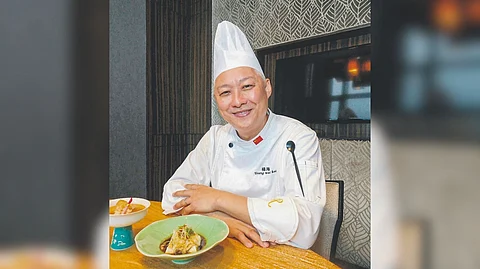
- NEWS
- the EDIT
- COMMENTARY
- BUSINESS
- LIFE
- SHOW
- ACTION
- GLOBAL GOALS
- SNAPS
- DYARYO TIRADA
- MORE

Chef Raymond Yeung, from Hong Kong, lives and breathes Cantonese cuisine. At Lung Hin, the signature Cantonese restaurant on the 44th floor of Marco Polo Ortigas Manila, he has built a menu and trained a team that blends centuries of tradition with modern flair.
When I sat down with him for an interview, what stood out wasn’t just his mastery of technique or his eye for detail — it was his enthusiasm. He spoke about how he continues to learn from every dish he creates, even after decades in the kitchen. Chef Raymond isn’t just a chef; he’s a walking culinary library who still reads cookbooks in his spare time, often borrowing from local libraries when working abroad. His collection at home, he says, is in the hundreds.
He trained for a decade under old-school masters, where he learned the backbone of traditional Cantonese cuisine. In 2008, he began experimenting with modern Chinese dishes and even won a gold award in a vegetarian modern cooking competition at the Hong Kong food expo.
That thoughtfulness was on full display with his signature dishes. The steamed silky egg custard topped with lobster and bird’s nest is a small dish that leaves a big impression. The soft egg carries a light savory flavor that soaks up every bit of the bold, lobster-infused broth. The bird’s nest adds texture and elegance, and if you’re lucky enough to try it, you’ll wish it came in a larger bowl. The lobster was, of course, perfectly creamy and cooked to perfection.
Then there’s the wild tiger grouper fillet. Who hasn’t had steamed fish with a light, gingery sauce? But this elevation, delicately steamed and topped with salted kiat kiat sauce, balanced sweet, citrusy and savory notes in a way that felt effortless yet methodical. The use of kiat kiat — those small Mandarin oranges associated with Chinese New Year — adds symbolic flair as well as flavor. “People only remember them for the holidays,” Chef Raymond said with a smile. But, why not make the whole year auspicious — and delicious?
We also talked dim sum, another highlight among Lung Hin’s many. Their steamed shrimp dumplings or hakaw delivers that satisfying snap of perfectly cooked shrimp. And the siu mai? It’s proof that even something familiar — from train station kiosks and casual Makati Avenue eateries — can still surprise you, especially when the ingredients are this fresh and the execution this precise.
Speaking of freshness, our conversation turned, naturally, to seafood. As you might expect from a Cantonese chef, quality is non-negotiable. He educated me on how best to determine whether a fish, like his signature grouper, is caught in the wild or raised in a pen. Imagine, one way to tell is by looking at the fish’s teeth! “I choose the seafood myself,” he said, also explaining how to gauge freshness by looking at scale color and the silhouette of the wannabe Lazy Susan centerpiece. “Even wild-caught seafood can lose its flavor if it sits too long in an aquarium.”
Yeung also emphasized how important it was to know the story behind the ingredients he uses every day. At one point, he launched into an account of how soy sauce is made and how oyster sauce, now a pantry staple, was more of an accidental discovery than a deliberate invention.
He also spoke about how Chinese and Filipino cultures have intersected over the years, especially in food. Spring rolls, for example, have been localized over generations. “Every place makes their own version. That’s how cuisine evolves.”
But evolution never means carelessness. Whether it’s the chef’s signature lobster custard or the humble siu mai, each dish gets the same level of attention.
On my last visit, I raved about Lung Hin’s deep-fried pork spareribs with plum sauce. Chef Raymond confirmed it was one of his favorites, too. Like his grouper and kiat-kiat, it’s another dish that effortlessly balances savory and fruity, floral flavors, but this time with plum sauce and osmanthus. Fascinated — and full — I realized that I wouldn’t trust anyone more than Chef Raymond to source my seafood, simmer my broth, or steam my dumplings. His passion is contagious. At Lung Hin, he’s not just upholding a centuries-old tradition — he’s inviting diners to be part of its next chapter.
